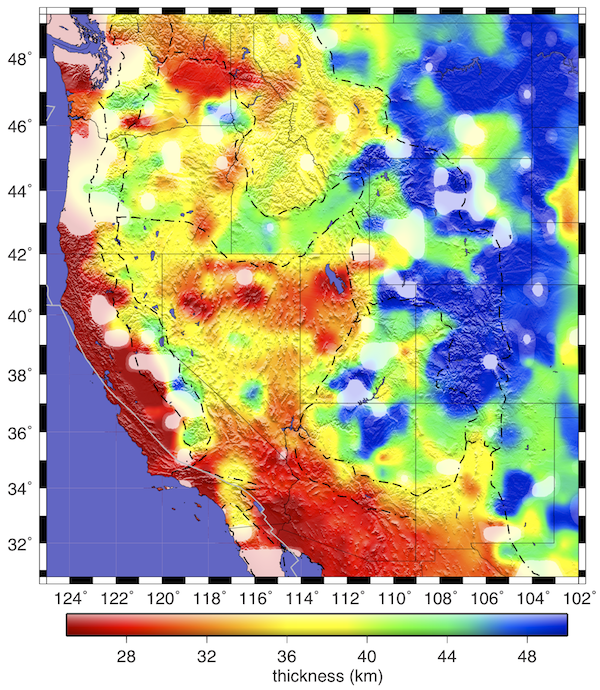2012 IRIS Workshop
Crustal Structure of the Western United States
Hersh Gilbert: Purdue University
Crustal thickness map. Blue colors mark areas of thicker crust and red colors correspond to areas of thinner crust. The intensity of colors correspond to the confidence of the receiver function pick used to determine crustal thicknesses. Regions where the base of the crust can be clearly identified are plotted at full intensity, while areas with higher uncertainties in crustal thickness are plotted as less intense colors.

Full-resolution graphics file in original format: 0124.ai
Previous investigations spanning a range of scales in the western cordillera of North America have sought to unravel details of its structure and evolution. By sampling the entire western portion of the United States, the deployment of the Transportable Array component of the EarthScope USArray provides broadband seismic data to study crustal structure across much of this region, which has a long history of deformation. Receiver functions recorded across the western United States indicate that crustal thicknesses reach >50 km within the Rocky Mountains and <30 km thick within the southern Basin and Range. The entire Basin and Range, Snake River Plain, the Sierra Nevada, and the active Cascade volcanic arc are characterized by distinct crustal structures, suggesting that the processes responsible for forming each region have shaped the structure of the crust. Additionally, characteristics of the crust appear to relate to the boundaries of, and structures within, the terranes that accreted together to form North America. Investigating crustal thickness across the expansive region presented here allows for the crustal response to specific tectonic processes to be determined.
Acknoweldgements: Grants EAR-0454558 and EAR-0454554 from the National Science Foundation supported this research. The collected data that contributed to this work are available through the IRIS Data Management Center. The National Science Foundation supports the facilities of the IRIS consortium under Cooperative Agreement EAR-0004370.
For further reading: Gilbert, H., Crustal structure and signatures of recent tectonism as influenced by ancient terranes in the western United States, Geosphere, doi:10.1130/GES00720.1, 2012. doi: 10.1130/GES00720.1
Keywords: receiver_function
